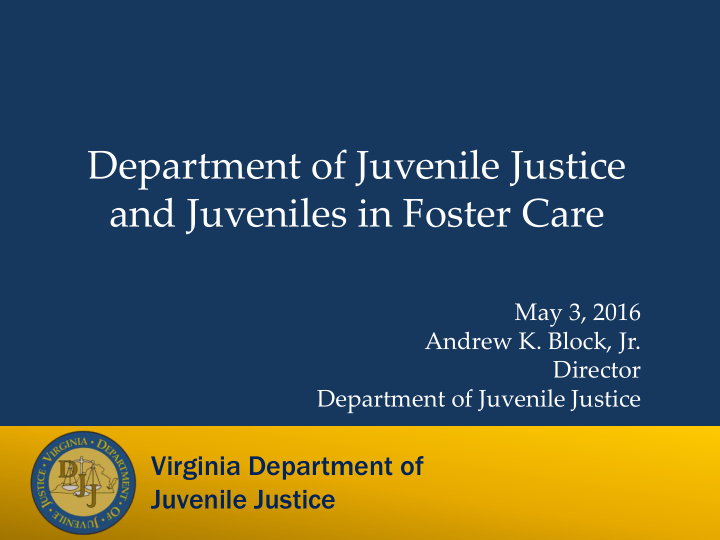



Department of Juvenile Justice and Juveniles in Foster Care May 3, 2016 Andrew K. Block, Jr. Director Department of Juvenile Justice 1 Virginia Department of Juvenile Justice
Committed Juveniles in Foster Care, FY 2004 – 2013 14% 13% 12% 12% 11% 10% 10% 10% 9% 9% 10% 8% 8% 8% Immediately Prior to Admission 6% Previously 4% 3% 4% 3% 3% 2% 1% 1% 1% 2% 1% 1% 0% 2004 2005 2006 2007 2008 2009 2010 2011 2012 2013 • Between 1% and 4% of juveniles lived in foster care immediately prior to admission. • Between 8% and 10% juveniles previously lived in foster care at some point in their lives. 2 * Data include juveniles admitted to direct care each year.
Committed Juveniles in Foster Care by Race, FY 2004 – 2013 120 96 100 Number of Juveniles 80 60 35 40 20 5 0 Black Other White • 66.4% of committed juveniles were black. • 70.6% of committed juveniles living in foster care immediately prior to admission were black. * Data include juveniles admitted to direct care during the timeframe. Data show juveniles who were in foster care 3 immediately prior to admission.
Committed Juveniles in Group Homes, FY 2004 - 2013 35% 32% 30% 27% 28% 27% 27% 25% 25% 24% 23% 23% 20% 19% Immediately Prior to Admission 15% Previously 10% 5% 4% 4% 4% 4% 4% 5% 3% 3% 2% 2% 0% 2004 2005 2006 2007 2008 2009 2010 2011 2012 2013 • Between 2% and 5% of juveniles lived in a group home immediately prior to admission. • Between 19% and 32% of juveniles lived in a group home at some point in their lives. 4 * Data include juveniles admitted to direct care each year.
Committed Juveniles in Group Homes by Race, FY 2004 - 2013 160 143 140 120 105 Number of Juveniles 100 80 60 40 20 10 0 Black Other White • 66.4% of committed juveniles were black. • 55.4% of committed juveniles living in a group home immediately prior to admission were black. * Data include juveniles admitted to direct care during the timeframe. Data show juveniles who were in group homes 5 immediately prior to admission.
Legislation During 2013 and 2014 General Assembly sessions, legislation was passed with bipartisan support and signed into law by Governor McDonnell which provided that local departments of social services and licensed child-placing agencies may make independent living services available to persons 18 to 21 years of age who are released from commitment to DJJ after reaching age 18. 6
Interagency Collaboration Memorandum of Agreement (MOA) between DJJ and Department of Social Services (DSS) – Gap in Continuum of Services and Lack of Coordination – Children’s Cabinet Directive – Inter-agency Workgroup – Best Interests – Agency and Collaborative Responsibilities 7
DJJ/DSS MOA • Applies to juveniles who are in foster care at time of their commitment (who will be under the age of 18 at release) – Requires ongoing collaboration and partnership, including family involvement – Case is classified as foster care prevention during commitment – Clarifies that funds will be available for continued local department of social services (LDSS) involvement throughout commitment • Custody reverts to LDSS at conclusion of commitment 8
Recommend
More recommend